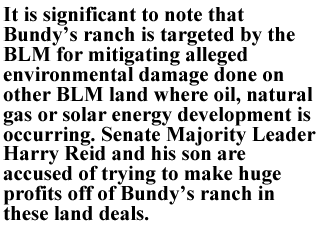THE BUNDY STANDOFF—A
CENTURY OF ABUSE
PART 5
By
Michael S. Coffman, Ph.D
July 19, 2014
NewsWithViews.com
Part V—Years of Tyranny Take Their Toll Leading to the Standoff
By 1916 Western ranchers began to realize the somewhat friendly relationship with the U.S. Forest Service was a fraud designed to trap them in contractswhichgave the government the right to set grazing requirements that would gradually put them out of business.
BY 1916 THE WORST FEARS OF THE RANCHERS started to materialize. Their stockmen’s associations began to be weakened by “eastern” professionals, usually foresters, which returned to the original objectives of the northern core interests. The Forest Service became uneasy because the banks were beginning to recognize the rancher’s grazing rights as real property. Says Hage, “Bankers loaned money on the collateral value of the entire ranch including range and water rights on the forest. When ranches were sold the range and water rights were a part of the ranch sale.”[1]
The
Forest Service had to stop this or they would lose control of the entire
 forest
reserve program. So they discouraged range im¬provements and began
to hike up grazing fees to make it impossible to raise cattle commercially
– just as is happening today. The same arguments were used in
1919 to raise grazing fees as today; “Low fees cause overgrazing,”
“Fees should be raised to market value for the privilege,”
“An immediate 300 percent increase should be im-posed.”[2]
Of course, easterners then, like urban¬ites now really do believe
the grazing fees are ridiculously low. They have no idea of the enormous
costs necessary to keep a herd healthy over sometimes tens of thousands
of acres of land.
forest
reserve program. So they discouraged range im¬provements and began
to hike up grazing fees to make it impossible to raise cattle commercially
– just as is happening today. The same arguments were used in
1919 to raise grazing fees as today; “Low fees cause overgrazing,”
“Fees should be raised to market value for the privilege,”
“An immediate 300 percent increase should be im-posed.”[2]
Of course, easterners then, like urban¬ites now really do believe
the grazing fees are ridiculously low. They have no idea of the enormous
costs necessary to keep a herd healthy over sometimes tens of thousands
of acres of land.
Tension continued to build. By 1925-26 stockmen were able to get several pro-ranching grazing bills introduced in Congress. Committee hearings garnered publicity unfavorable to the Forest Service. The Forest Service countered through the eastern conservationist press; just as is happening today. Heartwarming conser-vation stories were published in the American Forestry Society’s periodical, American Forests and Forestry. The New York Times, then as today, along with the Saturday Evening Post wrote negative stories about ranchers. Nothing, it seems has changed from then to now. One of those stories was written by Chief Forester Greely where he amaz¬ingly admitted the ranchers were prior users of grazing rights, while never sanctioning the claim as a vested right of property interest in forage. Relates Hage:
Greeley referred to the ‘handful of stockmen and their leaders who were attacking the basic policy that governed the forest ranges.’ He condemned the demand by the stockmen that grazing rights be confirmed by laws as an attempt to secure special privilege for a few users who would then have the right to sell these privileges at high prices. Greeley pointed out that the Department of Agriculture had always recognized the rights of prior users of grazing lands. ‘It has never, however,’ he declared, ‘been able to sanction the claim to a vested right of property interest in forage. On the contrary, it has regarded that conception as absolutely inimical to the principles of conservation.”[3]
Progressives
have always used emotion-laden words, not facts to make their case.
That’s especially true today.Using deception, Greeley turned the
only  fact
he used, vested right of property interest in forage, into the absolute
enemy of conservation. A vested right is a constitutional right and
Greeley made it out to be the most destructive thing in the world. The
Forest Service did everything they could to deny ranchers havingprior
rights or the state from getting control of their own grazing rights.
fact
he used, vested right of property interest in forage, into the absolute
enemy of conservation. A vested right is a constitutional right and
Greeley made it out to be the most destructive thing in the world. The
Forest Service did everything they could to deny ranchers havingprior
rights or the state from getting control of their own grazing rights.
Suffice it to say that from a Constitutional standpoint, the states most likely had, and still have jurisdiction over grazing, not the Forest Service. Grazing rights remained in a legal quagmire. They still are. However, the states during this period finally passed extensive statutory water law to strengthen their control of water on the federal lands within their borders.[4]
Constitutionally, the western states should also be given the federal lands as per the Equal Footing Doctrine in the U.S. Constitution.However, there is a legal cloud over these issues because they have never been decided at the Supreme Court. Circumstantial evidence suggests the cloud has been deliberately created and maintained by very powerful progressive judges and outside forces. It is suspected by many constitution advocates that these judges and outside forces don’t want this issue before the Supreme Court so they can rule with fuzzy case law that is stacked against the landowner.
The northern core panicked again in 1929 when President Hoover attempted legislation to privatize federal land. By that time the Forest Service’s appropriation had grown from less than a million dollars in 1905 when it was created to over fifteen million dollars. Privatization would destroy that growing bureaucracy and prevent the northern core from transferring its wealth into the pockets of the northern core industrialists. A major propaganda effort was launched and Hoover’s effort was stillborn.[5]
It is clear that the “resource damage” argument has been used since 1900 to “accomplish Forest Service objectives, without the dangerous issues of economic damage and the taking of private property without compensation,” claims Hage. “The Forest Service would be able to economically damage and take the property of uncooperative stockmen without raising the Fifth Amendment of the U.S. Constitution challenge with its guarantees of due process of law and just compensation.”[6]
That’s exactly what was happening to Wayne Hage in the 1980s. He was soon to find out the truth of his words as the enormous power of the Forest Service was to crash on his ranch as punishment for writing his 1989 book, Storm Over Rangeland. The ensuing legal battle lasted 24 years. He won all but one point of what is discussed above. Grazing rights.
Taylor Grazing Act of 1934—A Blessing and Curse
 Lands
included in the Taylor Grazing Act of 1934.
Lands
included in the Taylor Grazing Act of 1934.
Stockmen now had forty years of dealing with a federal government that seemed out to destroy them since the 1891 Forest Reserve Act. That Act dealt only with forest reserves. There was still nearly 250 million acres of non-forested land to deal with; 80 million acres of it was rangeland. The northern core and conservationists began to call for the creation of something like the Forest Service for the non-forested lands. It was ob¬vious to ranchers that the federal government and northern core were set on stripping them of their private property rights. Ranchers and western state interests demanded that express protection of property rights be engrained in any new legislation. That legislation was the Taylor Grazing Act of 1934.
The Act created the Division of Grazing, which was renamed to the U.S. Grazing Service. Eighty million acres of the 240 million acres were immediately placed in grazing allotments. On July 16, 1946, the Grazing Service and the General Land Office merged to form the Bureau of Land Management (BLM) and moved into the Department of Interior.
Pre-existing water rights were specifically recognized in the legislation as were private investment in range improve¬ments as well as rights of ways and all other prior existing rights. Every section within the Act started with “Nothing within this sub-chapter” shall violate or diminish whatever previous property right the Act protected. State rights were protected with similar language in Section I. Virtually no water on the federal lands was unappropriated by 1934.
In spite of the specific language for other rights, the ranchers’ property rights for grazing rights still remained mixed, at best. The northern core was not that interested in prior rights on these lands because they believed no commercial minerals or forest resources would be found there. However, whatever legal decisions were made on BLM rangeland would be carried over to the Forest Service public land where it would directly affect them.
In retrospect, it is perhaps poetic justice that much of that BLM land could now be producing a bonanza of low sulfur coal, oil and natural gas in some of the biggest shale deposits in the world—if President Obama allowed it. As it is the Obama administration is only allowing a small portion of the BLM lands to open to oil development. It is significant to note that Bundy’s ranch is targeted by the BLM for mitigating alleged environmental damage done on other BLM land where oil, natural gas or solar energy development is occurring. Senate Majority Leader Harry Reid and his son are accused of trying to make huge profits off of Bundy’s ranch in these land deals.
Consequently, special interests funded by the northern core or their foundations have attempted to use the last sentence in Section III of the Act – “the creation of a grazing district or the issuance of a permit creates no right, title or interest in the land.” – as meaning the ranchers had lost their rights. However, courts have determined that the first sentence in Section III that the law could not diminish any rights whatsoever made it clear that the last sentence was meant for permittees having no prior rights. Even though northern core supporters failed, the argument is still used today as justification for their continued attacks.[7]
There
are three types of permits. One for ranchers that who actually own  adjacent
fee titled land and have pre-existing rights on the federal land. The
second for ranchers having no fee land of their own, but still have
pre-existing rights of their own on the federal land. The third has
no pre-existing rights on federal land. Some special interest groups
have tried to explain the pre-existing water rights do not imply grazing
rights. They claim, explains Hage, “that the water rights are
only valid as stock water rights when they flow on to the commensurable
private lands. Therefore livestock grazing—which is proof of beneficial
use—occurs on private, not federal land.”[8]
Consequently, prior rights do not exist and grazing permits as a privilege,
not a right.
adjacent
fee titled land and have pre-existing rights on the federal land. The
second for ranchers having no fee land of their own, but still have
pre-existing rights of their own on the federal land. The third has
no pre-existing rights on federal land. Some special interest groups
have tried to explain the pre-existing water rights do not imply grazing
rights. They claim, explains Hage, “that the water rights are
only valid as stock water rights when they flow on to the commensurable
private lands. Therefore livestock grazing—which is proof of beneficial
use—occurs on private, not federal land.”[8]
Consequently, prior rights do not exist and grazing permits as a privilege,
not a right.
This argument does not carry water either. Many streams, springs, and other water flowage never leave federal land and yet ranchers have preexisting rights to them. It does illustrate, however, the constant nuisance lawsuits by special interest groups funded by the northern core foundations that ranchers have to spend time and money to defend against. Hage provides summaries of some of the key District Court cases that are used as precedent that no grazing rights exist.[9] Notes Hage:
“These court decisions are often presented as proof that no pre-existing grazing rights were protected by the Taylor Grazing Act. But each of these cases plainly discuss grazing permits as revocable and non-compensable. They just as plainly do not mention water rights or in any way reference the proof of beneficial use for those waters. They do not discuss the prior appropriation doctrine or any rights that have “vested or accrued under existing law validly affecting the public lands.”[10]
Under the Taylor Grazing Act, as well as national forest regulations, permits were granted only to those who could prove they had valid prior rights. Bundy apparently has this chain of title. Hage correctly notes: “The rights were not created by the federal government and were clearly not revocable by the federal government.”[11] These court cases demonstrate that the Federal government had the right to revoke a permit, but not the underlying property rights. Such is the deliberately created confusion surrounding the split estate. Grazing rights remained in limbo.
The United States Court of Appeals for the District of Columbia in the 1938 case Red Canyon Sheep Co. c. Ickes came close to resolving the grazing rights, but stopped short of doing so, by merely saying the Taylor Grazing Act was passed to “define grazing rights and to protect those rights by regulation against interference.[12] That says nothing of value to clear away the fog.
These types of lawsuits systematically filed by special interest groups and funded by the northern core or their foundation proxies; create superfluous court decisions in which confusion is maximized and no clarifying legal resolution is reached. Hage adds, “Containment of the underlying property rights issue has primarily been accomplished by federal land management agencies by settling threatening disputes before they reach the federal courts.[13]
The Federal Land Management Act of 1976
The Federal Land Policy and Management Act (FLPMA) of 1976 was passed under what could only be described as an all-out and well financed campaign by environmental groups to pass it. Congress even had the hubris to claim out of thin air that the public lands belonged to the federal government: “Congress declares that it is the policy of the United States that the public lands be retained in Federal ownership; unless…it is determined that disposal of a particular parcel will serve the national interest.” Just because the government proclaims it, doesn’t make it so, especially if there is no constitutional provision for it.
The effort to pass FLPMA was funded by the same northern core foundations. The goal was to once and for all destroy any vestige of prior property rights held by ranchers. They used the same strategy as the Forest Service used in 1916; i.e. use the vague ambiguous mandate of the Act of June 4, 1897, “to protect the preserves,” as a basis to demand livestock reductions or costly management practices that served to increase the rancher’s cost-of-use. If pseudo¬science is used to justify livestock reductions (see part VI), while making it more expensive to operate, there would come a time when the rancher must go out of business. As in the case for 57 of Bundy’s fellow ranchers and those across the West, it is a brutally effective weapon.
It is important to understand that ranchers must demonstrate they and their predecessors have used their prior water rights continuously since the Treaty of Guadalupe Hidalgo. If they discontinue use for any reason, even when they no longer have cattle or sheep because the BLM or Forest Service successfully contrived to reduce herd size to nothing, they lose their prior water rights after a specified period of time. In other words, the rancher must make continuous use of his prior rights in order to keep them. Bundy claims he has that chain of title that gives him title.
Once lost, the prior rights go to the federal govern-ment. Wayne Hage v. the United States (Part VI) may change that but the federal government will make every attempt to stay away from that decision because the decision was such a disaster to them. The government, for all its criminal activity, gets off scot free. After all, they didn’t take the rights from the rancher as defined by the U.S. Constitution. They were merely “protecting” the resource. In other words, our government agencies have become an immoral mafia, dedicated to destroy ranchers.
The Politically Correct Defeat of Cliven Bundy
If enough attention is generated to create a public backlash against the abusive treatment of western rural ranchers and citizens, it is likely these northern core progressives will fail because of exposure and the realization they have no constitutional grounds to start with. The Bundy Ranch standoff might have generated that backlash, but the New York Times (NYT) deliberately edited a foolish talk by Bundy on Negros and slavery to make him sound like a raving racist. Although he certainly used the wrong choice of words, videos showed he was, in fact, trying to show how federal programs are hurting, not helping the black community; not unlike what they have done to ranchers.Several black leaders supported Bundy as being right. His comments, while crude and offensive, were in no way racist.
|
|
While the NYT was shown to deliberately make Bundy into a rabid racist when he wasn’t, it was too late. Perception is everything and by the time the lie was revealed, the public had the perception that he was a racist locked in their minds. The NYT achieved its goal without any backlash against it for lying. Its hateful political correctness article, however, did cause conservative media to flee from Bundy like rats on a sinking ship; lest they be tainted by politically correct accusations of racism. Meanwhile Bundy’s civil rights were deeply violated in the BLM assault. Political correctness apparently now trumps constitutional rights. We are living in dangerous times.
The federalgovernment simply does not have any constitutional grounds to own those vast western land areas in the first place.However, because of the corruption of case law, unscrupulous lawyers have twisted constitut¬ional intent into something almost exactly the oppositeby usingDistrict Court case law. With this information, is easier to understand how Bundy’s losses in District Court mean nothing constitutionally and how most pundits and talking heads don’t have a clue what they are talking about. And yet, they blindly continue to support those who are producing the very food we require to live.
Click here for part -----> 1, 2, 3, 4, 5, 6,
Footnotes:
1.
Wayne Hage. Storm Over Rangeland. (Merrill Press, Bellevue,
WA, 1989).P. 175
2.
Ibid, P. 175
3.
William B. Greely, “The Stockmen and the National Forests,”
Saturday Evening Post, November 14, 1925, pp. 10-11, 89, 82,
84. George F. Authier, “Both Sides of the Range Controversy,”
American Forests and Forest Life, Vol. 31, December 1925, pp. 715-770.
IN: Hage, P 176.
4.
Hage, P. 181.
5.
Hage, P. 178.
6.
Ibid, P. 177.
7.
Hage, P. 179, 183-184.
8.
Hage, P. 185.
9.
Mollohan v. Gray, 413 F. 2d 349, June 17, 1969; Acton v.
United States, 401 F. 2d 896, October 4, 1968; United States v.
Cox 190 F. 2d 293, June 21, 1951; Oman v. United States 179
F. 2d 738, Tenth Circuit Court of Appeals, December 19, 1949; Bowman
v. Udall, 243 F. Supp. 672 (1965); Placer County Water Agency
v. Jonas 275 Cal. App. 2nd 691, 80 Cal. Rptr 252 (1969); Fauske
v. Dean, 101 N.W. 2d 769. (1960); United States v. Fuller 409
U.S. 488, Decided January 16, 1973.
10.
Hage, P. 186.
11.
Ibid, P. 187.
12.
Red Canyon Sheep Co. v. Ickes, 98 F. 2d 308.Decided May 27, 1938 by
the United States Court of Appeals for the District of Columbia.
13.
Hage, P. 187.
� 2014 Michael Coffman - All Rights Reserved











 Share
This Article
Share
This Article





